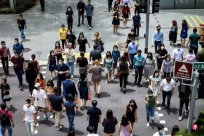Source: Bloomberg
China's shrinkage momentum is difficult to curb.In the last quarter, a price index appeared the longest duration tightening since the Asian financial crisis at the end of the 1990s.The weak demand will continue to make the economy in 2024, bringing new challenges to the decision makers.
The following explanation of China's contraction status, and when it is possible to end:
1. How do China merge about shrinkage?
There are three main indicators.The most cited is the consumer price index, which reflects the changes in a series of commodities and service prices.In December last year, it set the longest consecutive decline since 2009.The producer price index measures the changes in the price of industrial products sold by the manufacturer, which has been shrinking for more than a year.Both were released by the Bureau of Statistics.
The low domestic product reduction index is an unofficial indicator, which is calculated by the difference in the difference between the nominal economic growth and the growth rate of inflation.It provides a wider range of overview, which is currently in the longest contraction cycle in nearly 25 years.
2. What drove consumption to shrink?
According to the analysis of CPI in Bloomberg's research, the decline in food prices is the biggest contributor.The index contracted for the third consecutive month in December, but food prices fell for the sixth consecutive month.In food, the decline in pork prices was particularly obvious, and last month fell by 26%.
3. Should we worry about food shrinking?
Some of the factors behind food shrinkage are periodic.For example, pig farmers expand their output to seize the rise in prices, but as the supply is greater than demand, it has triggered a decline in the market.In 2023, pork output reached a nine -year high.Another influencing factor was that the epidemic in 2022 caused logistics to be interrupted and pushed the prices of vegetables, fruits and eggs, which led to a higher base, which made the trend of price decline this year look particularly bad.
Even if this is considering this, the unscrupulous food demand reflects deeper problems in the economy.Faced with the downturn's employment market and a downturn in the real estate industry, family reduction in expenses led to some major production provinces that piled up cabbage and radish at the end of last year.
Last year, Chinese families spent about 30%of the total expenditure on food, tobacco and alcohol, and it was reasonable to constitute a pressure on the CPI basket.
4. What other categories of products are falling?
Transportation category is another factor in dragging the price. This category dragged the overall CPI for the 10th consecutive month in December last year.It is mainly affected by the decline in automobile prices.In 2023, a fierce price war broke out between auto manufacturers including Tesla and BYD. Nearly 900 models reduced their prices sharply, exceeding 5%.
According to Bloomberg's calculation, China's GDP decrease index was negative last year, and the manufacturing price fell the largest, reaching 3.2%.Although consumers from all over the world may benefit from cheaper Chinese products, if domestic brands are in adverse situations, they may exacerbate trade tensions.
5. Is there any dazzling?
Some sections also have signs of mild inflation, but the price is far lower than the level before the epidemic.The core CPI that eliminated food and energy was below 1%last year. In contrast, it was 1.6%in 2019.
A field worthy of attention is the service industry.The service industry, including education, medical and takeaway, rose 1%in December and contributed 0.4 percentage points to CPI.But even these data are not as good as people's expectations of the economic rebound in the post -epidemic era.
Some reasons for consumer demand is that the disposable income of the family has not improved significantly.Some consumers are seeking consumer downgrade and looking for cheaper substitutes.
Tourism is an exception.Tourism inflation rose 6.8%last month, and in August, it once touched the nearly 10 -year height of 14.8%.Tourism is a sub -class in the split items of culture and education, which accounts for 8.5%of the CPI.
6. Will the tightening tightening be relieved in 2024?
Economists seem to think so.According to Bloomberg data, they predict that the average inflation rate in China in 2024 was 1.4%.Although it has improved, it is still low and may be boosted by the lower base of last year.
But not everyone is so optimistic.Barclays, UBS, Nomura Securities and other expected will be maintained below 1%.Bloomberg Economic Research believes that 50%of the possibility will continue to continue in the first half of 2024.
The government said the decline in prices was "temporary."The Director of the National Bureau of Statistics of China said this week that the rebound of commodity prices and service prices has a good foundation and conditions.In view of the improvement of the economy and the steady growth of household income, domestic demand will also expand.
7. What can China do?
The effect of curbing the tightening of currency is not effective.More and more people have called for officials to take interest rate cuts and reduce bank deposit reserve rates more aggressively.Last year, the government took these two measures, but both had little effect.
Promoting consumer confidence will encourage expenditure.The core is to stabilize the real estate market, and real estate accounts for a considerable part of household wealth.Officially provided long -term funds with low interest rates to policy banks to support loans to the real estate industry, but more support measures are needed.
Due to the continuous weakness of domestic demand, it may drag the import and affect domestic tourists to travel abroad, which has also made China's currency austerity a global concern.
"Consumption downturn, because the family is worried about the prospect of income," said Duncan Wrigley, chief Chinese economist at Pantheon Macroeeconomics."Don't expect China to reverse the slowdown of global growth this year."



